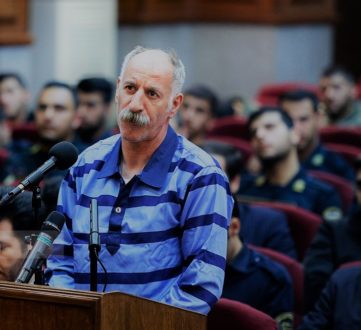The criminal trial of Mr. Yavar Mohammad Salas, presided by Judge Mohammadi Kashkooli, has reached a verdict that is extremely worrying and in need of immediate attention. After three consecutive court hearings, on 19th March 2018, Mr. Salas was given the death sentence, despite the fact that the murder case against him remains incomplete and unsubstantiated, with no credible evidence that proves Mr. Salas as guilty. This death sentence is being forced upon him, and his case is being rushed in every way possible by the prosecution and the Regime, in order to expedite the conviction and execute Mr. Salas. As outlined below, even though there is compelling evidence proving Mr. Salas’ innocence, the Court has blindly given him the death penalty as part of the Regime’s plan to target and execute him, as means to a greater plot of going after the spiritual leader of the Gonabadi Dervishes, Dr. Noor Ali Tabandeh, at age 91. This is an extremely critical matter which needs immediate intervention in order to stop the execution of Mr. Salas who is innocent and is being prosecuted in a case which has quickly become an evil witch-hunt.
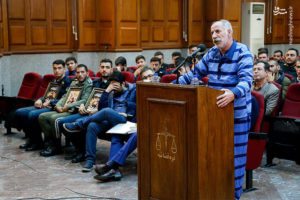
Mr. Salas, who was charged with the murder of three police officers, previously attended a court hearing on Sunday 11th March 2018, where he was not allowed to hire a Defence Attorney of his own choice to defend himself. Mr. Salas was also tortured and interrogated prior to the court hearing inside solitary confinement. False statements made by the prosecutor inside the court, to imply that Mr. Salas confessed to the murder charge of the three police officers, was absolutely negated by Mr. Salas himself during his previous court trial, where he rejected all allegations and pleaded ‘Not Guilty’. This entire case against Mr. Salas is a false and cruel accusation set up in an orchestrated attempt to forcefully sentence him to death and execute him. The court trial of Mr. Salas was initially being broadcasted live on Iran’s National Television that is controlled by the regime, in order to malign his image as a “criminal”, and was quickly shut down soon after Mr. Salas pleaded ‘Not Guilty’ and rejected all allegations made against him.
The case lacks any evidence of a murder weapon, and does not have any credible evidence to prove that the driver of the bus was Mr. Salas, or even place him at the scene of the crime. The prosecution does not have any confession from Mr. Salas, despite their repeated attempts to torture him in solitary confinement. The heavily tampered video clip which the Regime has tried to push as supposed evidence for the case, is clearly fabricated and tampered with, and therefore inadmissible as evidence.
There is substantial evidence proving the innocence of Mr. Salas, and the arguments outlined in the news article in the following link, strongly support his case.
The new evidence that has surfaced, makes it even more certain that Mr. Salas is innocent, and the murder charges imposed on him are entirely baseless and false.
The following arguments and evidence provide more support to Mr. Salas’ innocence –
- There is video evidence that was taken at the scene of the bus attack. In this video, the driver of the bus can be identified very clearly, and we can see that it does not match the facial features of Mr. Salas. The bus driver in the video can be seen having distinct black hair all the way to his forehead. Whereas Mr. Salas is a balding man, with only grey hair on the sides of his head. This video is credible proof via facial recognition, that Mr. Salas was not the driver of the bus.
- In his statements during the past court hearings, Mr. Salas has repeatedly said that he pleads ‘Not Guilty’, and does not accept any of the criminal charges that are being imposed on him. In his statements, Mr. Salas has clearly stated that he was not inside the bus involved in the attack.
What is clear is that there is a second bus in question, that was amongst the group of Gonabadi Dervishes, which Mr. Salas also had access to. Mr. Salas has explained in his statements that he had painted this bus, which can be identified by the distinct paintings of stars, trees and blossoms, all over its exterior body and windows. There is photo evidence of this bus that corroborates his statement and shows that this bus still exists, and that it is entirely different from the bus used in the attack. Mr. Salas explains that, as the Police and Basij force were beating him, he fled in order to take refuge inside this bus which he had access to, and drove it away while there were other Dervishes inside with him, and then stopped shortly after, upon which he got arrested and taken away. It is important to note that this arrest of Mr. Salas took place well before the bus attack.In contrast, the bus used in the attack, that ran over several people and killed three police officers, has evidence of heavy gunfire on it, with hundreds of bullet marks and the windows being shattered. In the following video of this said bus, recorded by the Basij Force, it can be clearly heard that the driver was killed inside the bus by heavy gunfire. This recording and video proof of the bus used in the attack, further proves that Mr. Salas was not the driver of this bus.
The question must be raised that if Mr. Salas was driving the bus of attack, why no investigation such as fingerprint analysis was carried out on the steering wheel of the bus? The fact remains that the only corrupt source that the court is using against Mr. Salas, is his own words taken out of context and attributing it to a second bus, which actually ran a crowd of people over, and resulted in the death of the bus driver.
- This case has an eye-witness to the bus attack – A Basiji, who was a victim of the tragic incident, and is related to the anti-riot forces and was brought in to confront the peacefully protesting Dervishes. This Basiji witness did an interview with a journalist from Tasneem News Agency, which is related to the Sepah Ministry of Intelligence of the Iranian Revolutionary Guards, and this interview uncovered the truth of the situation. The witness gave a first-hand account of the event in his own words, stating that the Basij Forces were preparing themselves from 1:00PM, and at 3:00PM they were called to go to the scene on Pasdaran Street, where the Basijis and Sepah were on one side, and the Dervishes were on the other side.
According to his statement, he said the following: “Actually, we [Basijis] were charging towards them [Dervishes], and they retreated. Then we [Basijis] took two steps back. I looked behind me, and saw that a bus has hit me. I came to stand up, and I realized that I cannot. Next thing I see is that I am in the hospital.”
The witness statement proves the following:
- The Basij Forces and Sepah were the first to attack the Dervishes and charge at them, while the peaceful Dervishes on the opposite side of the Basiji Forces, took caution and stepped back to avoid any sort of confrontation.
- The Dervishes and Mr. Mohammad Salas could not have driven the bus, as the bus ran into the crowd from the side of the Revolutionary Guards and Police Forces, and not the side of the Dervishes. This is justified by the witness stating that the bus attacked from behind him, where the Basij Forces and Sepah were stationed.
- In the three court hearings that took place during Mr. Salas’ trial, the testimony of this said witness was not included as part of the evidence, nor was the witness summoned into the court by Judge Kashkooli, to officially provide his testimony as part of the trial. By virtue of this, the death sentence given to Mr. Salas is no longer valid as the trial stands incomplete and there is a legitimate eye-witness whose testimony has not been accounted for in the decision. For these reasons, the death sentence given to Mr. Salas should be quashed and held void.
- In addition to the above arguments, it is important to understand just how fabricated and weak the case against Mr. Salas is, and yet the court gave him a death penalty based on no legitimate evidence whatsoever.
In a criminal trial, the prosecution typically presents a murder weapon used in the crime, which in this case would be the bus (as shown above) with shattered windows and gunfire-damage on it. In the latest court hearing for Mr. Salas, the prosecution attempted to present a murder weapon, and they brought in a few knives and wooden sticks, to be filed as supposed evidence of what was used to commit the crime. These knives and wooden sticks have absolutely no relation to the bus attack in question, and have no relation to Mr. Salas either.
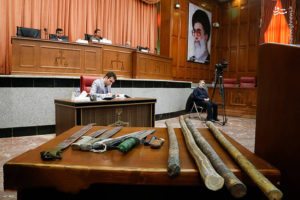
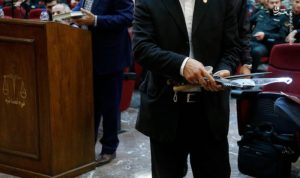 Instead of presenting pictures of the bus used in the attack, the authorities presented random unrelated items which were very clearly not the murder weapon. This shows how the authorities and the Regime are trying to present any mere token as “evidence”, just so that the court accepts it and moves forward forcefully with a death sentence. The authorities also claimed that these knives and wooden sticks were apparently being used by the Dervishes, while trying to pass these off as the murder weapon in Mr. Salas’ trial. This is a weak and desperate attempt of the authorities and the Regime, to vilify all Dervishes, and attach this court trial to the Gonabadi Sufi Order.
Instead of presenting pictures of the bus used in the attack, the authorities presented random unrelated items which were very clearly not the murder weapon. This shows how the authorities and the Regime are trying to present any mere token as “evidence”, just so that the court accepts it and moves forward forcefully with a death sentence. The authorities also claimed that these knives and wooden sticks were apparently being used by the Dervishes, while trying to pass these off as the murder weapon in Mr. Salas’ trial. This is a weak and desperate attempt of the authorities and the Regime, to vilify all Dervishes, and attach this court trial to the Gonabadi Sufi Order.
The authorities and the prosecution cannot present the bus used in the attack as evidence for the murder weapon, because it will become clear from the damaged state of the bus, that the driver could not have survived the heavy gunfire opened at the bus, and this would make it evident that Mr. Salas is not the driver, as he is alive and has no signs of gunshot wounds on him. The authorities also cannot present the second bus as evidence, which is the bus of Dervishes that Mr. Salas actually drove, because this bus is in pristine condition and undamaged, and has absolutely no signs of being involved in an attack. This is another reason why the authorities and prosecution tried to falsify evidence of the murder weapon. - Furthermore, the court is trying to blame Mr. Salas or other Dervishes for the death of Mohammad Hossein Haddadian, a Basiji killed in addition to the three police officers at the scene. As evident from the photograph of Haddadian after he was killed, it is clear that the wounds on his face do not match the murder weapons that were presented at the court trial of Mr. Salas. We can see very clearly from the photograph of Haddadian that he was shot to death, more precisely using Winchester Shotguns that are exclusively used by the Iranian Police Force and Anti-Riot Forces, and not at all accessible to the general public. Also, if the authorities had any proof that the Dervishes did infact have access to specialized weapons such as the Winchester Shotgun, they would have presented proof of it in the court. The reality is that the authorities did not seize any such firearms from Dervishes, and that is why the only thing they presented as supposed murder weapons, were wooden sticks and knives. By forcing forward such evidence, the authorities incidentally proved that the Dervishes and Mr. Salas have no relation to the death of Haddadian. This makes it certain that firstly, Haddadian died at the hands of the Police Force, who used Winchester Shotguns at him, and secondly, given the state of the bus of attack and his own injuries, it is extremely likely that he is also the driver of the bus.

This case highlights the deep-rooted corruption and failure of Iran’s Judiciary system, which is controlled single-handedly by the Iranian regime. This has resulted in an innocent man being sentenced to death. The arguments presented above, are clear reasons of why the conviction of Mr. Salas is not valid and lacks legal credibility. By virtue of this, the current death penalty should be cancelled and held void, and this entire trial should be conducted from the beginning in a fair and just manner.
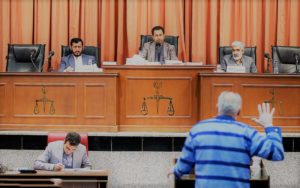
 Shabtabnews In this dark night, I have lost my way – Arise from a corner, oh you the star of guidance.
Shabtabnews In this dark night, I have lost my way – Arise from a corner, oh you the star of guidance.
